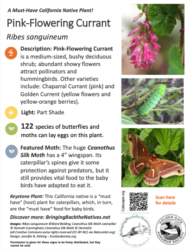Keystone Species

Why Garden with Native Plants?
Because Life Depends On It.
Local birds & insects need our help. They are in severe decline
because “traditional” gardens filled with exotic ornamentals and
lawns are “dead zones” for nature. Why? Because most insects need
the native plants they have evolved with to thrive and reproduce.
Birds, in turn, need insects, especially caterpillars, to feed their young.
You can make a difference when you plant natives, especially the “keystone species”—plants on which many species of moths and butterflies can lay their eggs because they are the right food for the emerging caterpillars.

Four Ways You Can Help:
1) Check out the Keystone Species plant information listed below in both English and Spanish, and learn more about these must-have plants that are not only beautiful, but also support insect and bird life in your garden. (You are welcome to download and distribute these cards; if you do, please consider making a donation to the Tour, here.) Interested in using these as garden signs? See * below.)
2) Grow keystone species in your garden and encourage neighbors and friends to do this, too. Together we can bring back the butterflies, bees and birds by growing the native plants that feed them.
3) Browse the Tour’s website – especially the Doug Tallamy section – to discover more resources. These include local native nurseries, seed sources, instructional videos, information on our virtual and live garden tours, and much more!
4) If you enjoy the Tour, or have found it useful, please make a donation now and help support our work! (Checks can be mailed to: Bringing Back the Natives Garden Tour, 1718 Hillcrest Road, San Pablo CA. 94806.)
“By including native plants in our gardens we can create
life, and by using nonnative plants, we can prevent it.”
Doug Tallamy 
Introductory Sign – 18×24 (see the bottom of this page for printing information)
(English | Spanish)
Asters | Symphyotrichum (English | Spanish)
Buckwheat – California | Flor de Borrego de California (English | Spanish)
Buckwheat – Overall Species | Flor de Borrego (English | Spanish)
Buckwheat – Redflower | La Flor de Borrego Roja (English | Spanish)
California Lilac | Lirio de California (English | Spanish)
Hollyleaf Cherry | La Baya Hoja de Acebo (English | Spanish)
Coffeeberry | La Hierba de Oso (English | Spanish)
Coyote Brush | La Escobilla (English | Spanish)
Currant – Pink Flowering | La Grosella Roja (English | Spanish)
Elderberry | El Sauco Azul English | Spanish)
Goldenrod | Escobilla (English | Spanish)
Gooseberry – Fuchsia-flower | La Grosella Fuscia (English | Spanish)
Hazelnut | La Avellana (English | Spanish)

Honeysuckle | Madreselva (English | Spanish)
Huckleberry | El Arándano (English | Spanish
Lupine | El Garbancillo (English | Spanish)
Manzanita – Species | Manzanita (English | Spanish)
Manzanita – Uva Ursi Point Reyes | Manzanita uva de oso (English | Spanish)
Maple – Big Leaf | Arce (English | Spanish)
Mountain Mahogany | Caoba de Montaña (English | Spanish
Oak – Black | Roble Negro (English | Spanish)
Oak – Blue | Roble Azul (English | Spanish)
Oak – Canyon | Encino (English | Spanish)
Oak – Coast Live | Encino Verde (English | Spanish)

Oak – Scrub | Encinillo (English | Spanish)
Oak – Valley | Encino del Valle (English | Spanish)
Oak – Oregon White or Garrya | Roble Oregón Blanco (English | Spanish)
Ocean Spray | Llovizna (English | Spanish)
Penstemon | Campanita (English | Spanish)
Rose | Salvia Colibrí (English | Spanish)
Sage – Hummingbird | Salvia Colibrí (English | Spanish)
Sage – Overall Species | Especies de Salvia (English | Spanish)
Sage – White | Salvia Blanca (English | Spanish)
Serviceberry | Guillomo (English | Spanish)
Snowberry | Perlita Blanca (English | Spanish)
Strawberry – Beach | Fresa Silvestre (English | Spanish)
Strawberry – Woodland | Fresa (English | Spanish)
Sunflower | Girasoles (English | Spanish)
Thimbleberry | Frambuesa Dedal (English | Spanish)
Willow – Red | Sauce Rojo (English | Spanish)
Willow – Arroyo | Sauce Arroyo (English | Spanish)
——–
These three plants are not Keystone Species, but as these are the only plants the pipevine swallowtail and monarch butterflies can lay their eggs on, signs were made for these plants, also:
Dutchman’s Pipevine | La Pipa Holandesa- (English | Spanish)
Milkweed – Narrow – | El Algodoncillo de hoja delgada (English | Spanish)
Milkweed – Showy | Algodoncillo(English | Spanish)
* These keystone species plant signs can be printed on 8.5 x 11″ paper or photo paper and laminated on a home laminator. Use 10 ml laminate to get a stiff page. Tape irrigation pins to the back to stake into the ground. They will fade in the sun, so are not recommended for long-term outdoor use.
The large Introductory Keystone Species sign can be printed at any copy shop for less than $20.
Endless thanks are due to the amazing Jennifer B. Dirking, at EcoGardenista.org, for creating these signs, and to Brenda Luna, and Rosa Chen for translating them into Spanish!
